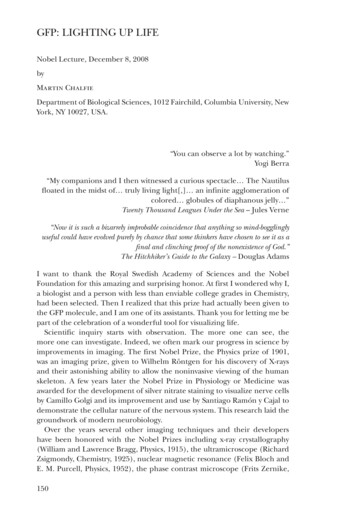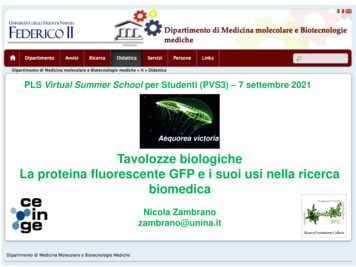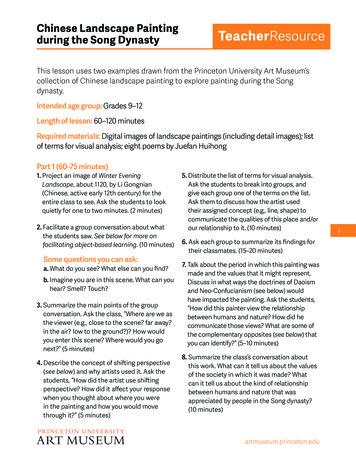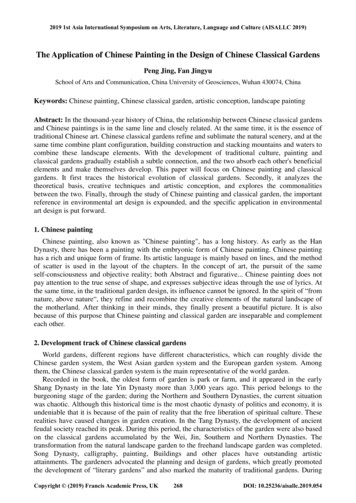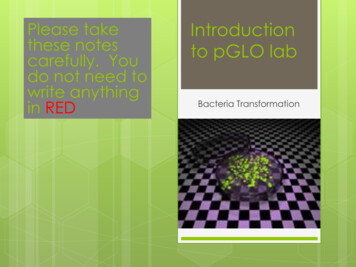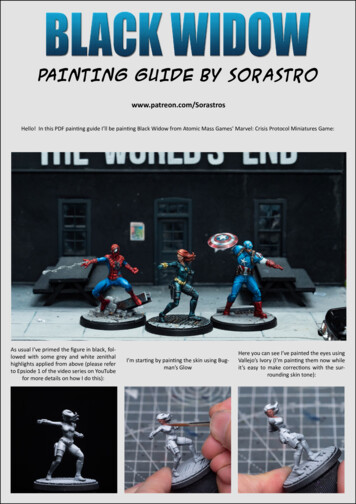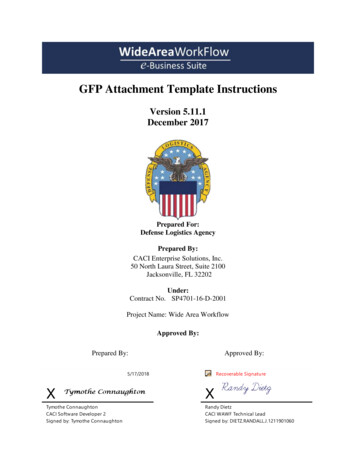
Transcription
Cutting-edge-sciencePainting life green: GFPIt started with a jellyfish: transparent Aequorea victoria has spotsaround its rim that glow green whenit is agitated; a behaviour that wasfirst described by scientists in 1955.Studying this ‘oddity’ led to what hasbeen hailed as a scientific revolution,and recently, for three scientists, to aNobel Prizew1. All because of a singleprotein, called green fluorescent protein (GFP), which is responsible forthe jellyfish’s fluorescence.In the early 1960s, Japanese scientistOsamu Shimomura discoveredaequorin, a jellyfish protein thatglows in the presence of calcium.However, aequorin glows blue, whilethe jellyfish glows green, so something must transform aequorin’s bluelight into the jellyfish’s green light.www.scienceinschool.orgImage courtesy of Typoform / the Royal Swedish Academy of Sciences (RSAS)From jellyfish to arsenicdetectors via a Nobel Prize:Sonia Furtado reports on thediscovery and development ofthe green fluorescent protein,and interviews scientists atthe European MolecularBiology Laboratory (EMBL)in Heidelberg, Germany,about its applications.GFP’s amino acid chain folds into theshape of a cylinder, with the fluorophoreat its centreShimomura discovered this something is another protein: GFP, whichabsorbs the aequorin’s blue and ultraviolet light and emits green light, giving the jellyfish its glow.Image courtesy Prolineserver; image source: Wikimedia CommonsNobel laureates in chemistry RogerTsien, Martin Chalfie, OsamuShimomura at a press conference atthe Swedish Academy of Science inStockholm, 2008Along came US biologist MartinChalfie with an idea how to make useof this effect: he reasoned that modelorganisms could be genetically engineered by attaching the gene for GFPto a specific gene that scientists wanted to study. Then, when the gene ofinterest was expressed, i.e. when theprotein it encodes was produced, itwould have GFP attached. Thiswould allow scientists to know whenand where a particular gene is turnedon: they would just have to shineultraviolet light onto their organismand look for the green glow.At the time, two things were apparently missing before Chalfie’s visioncould become a reality. The gene forGFP had to be identified, and themechanism behind GFP’s fluores-Science in SchoolIssue 12 : Summer 2009 19
Image courtesy of Typoform / the Royal Swedish Academy of Sciences (RSAS)Chalfie’s experiment: DNA with the gene for GFP attached was injected into the gonads of a C. elegans worm (a). The worm isa hermaphrodite, so it can fertilise itself, and the GFP gene was present in many of the eggs it then laid (b). The eggs divided (c),forming new individuals (d) whose touch receptor neurons glowed green in ultraviolet light (e)cence had to be unveiled. Scientistsknew that GFP glows because three ofits amino acids form a fluorophore, achemical group that absorbs andemits light. They assumed that, likemost naturally fluorescing moleculesknown at the time, other proteinscalled enzymes would be needed tofold GFP into the correct shape, andthought that only A. victoria wouldproduce them.geImacourtSo when biochemist DouglasPrasher identified the GFP gene in1992, the general consensus was thatintroducing this gene into otherorganisms would result in the production of a non-fluorescent versionof GFP. However, when Chalfie andhis team attached the newly foundGFP gene to a bacteria’s DNA, thebacteria glowed green!It turns out that GFP doesn’t needenzymes to make it glow. Instead, itspontaneously folds into the fluorescent shape, and, biochemist Rogern Ellenberg / EMBLesy of JaTo mature into an egg, thismouse oocyte is dividing.GFP was used to label thecell’s actin cytoskeletongreen and the chromosomes red20Science in School Issue 12 : Summer 2009Tsien discovered, the reactionbetween the amino acids in the fluorophore requires only oxygen, whichis readily available in most livingcells. Having established exactly howGFP’s fluorophore is formed, Tsienwas then able to manipulate this protein. By exchanging different aminoacids in different parts of the chain,he developed new versions of GFPwhich were brighter, absorbed light ofdifferent wavelengths, and glowed indifferent colours: cyan, blue and yellow. And, once a red fluorescent protein was found in coral, Tsien and hiscolleagues used their knowledge ofGFP to make that red fluorescent protein useable as a biological markertoo.Shimomura, Chalfie and Tsien wereawarded the Nobel Prize in Chemistry in 2008, “for the discovery anddevelopment of the green fluorescentprotein”, and scientists all over theworld have continued to developvariants of GFP which are now available in virtually all colours of therainbow.By now, GFP has become an invaluable tool for scientists all over theworld. It does much less damage tocells than chemical fluorescent markers do. After being illuminated for acertain period of time, a fluorophorewww.scienceinschool.org
www.scienceinschool.orgeagImesyurtcoo/ th ermofopyfTreleases an electron, and after that itwill never fluoresce again: it isbleached. The electrons released inthis bleaching process very quicklyreact with oxygen, forming highlytoxic oxygen radicals, which damagecellular components, eventually causing the cells to die. But GFP’s structure acts as a shield, protecting thecell. When the fluorophore releases anelectron, the radicals that are formedreact within GFP, so they do damageto GFP but not to the cell.And even though scientists use GFPas a marker by attaching it to a specific protein, different researchers use itto study different processes occurringon completely different scales, tagging anything from groups of cells toindividual molecules.“That’s the beauty of GFP,” saysDarren Gilmour, a scientist at EMBLw2:“with it, you can look at all these different scales – you can paint them allwith the same paint, you don’t needto change brush.” In their work onzebrafish embryos, Darren and hisgroup use GFP to tag groups of cells,which they can then follow as theembryo develops, watching how theybehave, where they go, and what tissues and organs they ultimately giverise to. The zebrafish embryos Darrenstudies are transparent, so you’dthink it would be easy to see whatwas happening in them. The problem,Darren says, is that there is too muchhappening. “It’s an overload. You justcan’t focus, you can’t pick out onething. But with GFP,” he adds, “youcan turn out the lights and just focuson a group of cells, or even on a single cell.” (To read more aboutDarren’s work, see Spinney, 2007).This ability to follow dynamicprocesses is also crucial for FrancescaPeri, as it allows her to follow thedevelopment of her labelled zebrafishembryos under a microscope for days.The alternative would be to sacrificethe animal, slice it and take still pictures. “It would be like trying tounderstand a football match basedish Academy of S ciences (RSAS)l SwedRoyaCutting-edge-scienceGFP was first discovered in the jellyfishAequorea victoriaon just half a dozen photographs,”says Francesca. “You’d never get thewhole picture.” She and her groupstudy microglia, cells which are ableto eat dying or damaged neurons.“Using GFP, we can colour-code thedifferent cell types, so microglia willbe labelled green, for example, andneurons red. So if we see a red cellinside a green one, we know that aneuron has been eaten to prevent itdamaging the rest of the brain tissue.”Marcus Heisler and his group useGFP and its variants to study plants.They focus on a plant hormone calledauxin, which is transported to theoutside of the cell by a carrier that sitson the cell membrane. This carrier canmove around the cell, changing thedirection in which it sends the hormone. “GFP allows us to follow thatvery dynamic process in livingplants,” Marcus says, “and it givesus good 3D resolution.”Image courtesy of EMBL PhotolabExposed to ultraviolet light, the GFP inthese tubes glows fluorescent greenScience in SchoolIssue 12 : Summer 200921
Image courtesy of Ernst Stelzer / Marcus Heisler / EMBLIn this 3D image of anArabidopsis plant’s shootapical meristem, whichwill give rise to the aboveground part of the plant,fluorescent proteins wereused to label cell membranes green and nucleipinkGFP’s reliability is crucial forobtaining such 3D images, says ErnstStelzer, whose group focuses ondeveloping technologies for 3Dimaging over time. “Getting the dyeinto a thick specimen is always a veryserious problem.” he says. Markersinjected into the specimens tend notto penetrate very well, so the labellingtends to be uneven: outer layers willbe well labelled, but ones near themiddle tend to be badly labelled, ifat all. “With GFP,” Ernst points out,“we can be really sure that the wholespecimen will be labelled, becausethe dye is produced inside thecells.”22Another EMBL scientist, RainerPepperkok, says, “With GFP, we canreally do molecular biology in cells,while things are moving, instead of ina test tube.” He and other scientiststake advantage of the fact that GFPnow comes in many different colours,and exploit a physical phenomenoncalled fluorescent resonance energytransfer (FRET). This phenomenonoccurs when two fluorescent molecules of different colours – classicallyred and green – come close to eachother. If the green one then receivesultraviolet or blue light, it will absorbthat light and transfer some of thelight’s energy to the red molecule,Science in School Issue 12 : Summer 2009which will then emit red light, in amanner similar to GFP glowing greenin the jellyfish thanks to the blue lightemitted by aequorin. “So if you havea protein tagged with green GFP andanother with RFP (red fluorescentprotein),” Rainer explains, “if theyinteract with each other, the red willbe brighter and the green will be dimmer.”Despite all of GFP’s different uses,or perhaps because of them, scientistsare still not satisfied. A commonrequest would be GFPs that glowunder red or even infra-red light, asthis penetrates biological tissues better. “It would also expand the specwww.scienceinschool.org
Cutting-edge-scienceImage courtesy of Marcus Heisler / EMBLCombining computer simulationswith GFP labelling, scientists cancompare their predictions (blue)with the real-life location of cellnuclei (orange)Image courtesy of Francesca Peri / EMBLWith GFP, scientists can look at a livingzebrafish embryo’s whole brain, observeinteractions between microglia (green)and neurons (red) and find neuronsinside microglia (bright red)Image courtesy of Darren Gilmour / EMBLOne group of cells, labelledorange, guides other cells(green) as they migrate along adeveloping zebrafish embryotrum of available colours,” JanEllenberg points out, “which wouldallow us to tag more proteins and follow them at once.” It may take a newdiscovery to make this wish cometrue, as Jan believes the standard wayof making GFPs which glow at longerwavelengths – stacking more aminoacids onto the fluorophore – is prettymuch exhausted. For his part, Darrensays microscopy techniques now needto catch up: “At the moment, we’re ata stage where we could make azebrafish with five colours, but then wewouldn’t be able to tell them apart withmost of the available microscopes.”Nevertheless, GFP is expandingwww.scienceinschool.orgbeyond the realm of science. It isemployed in some glow-in-the-darktoys, in glow-in-the-dark fish beingsold as pets, and even in bacteria thathave been genetically modified todetect arsenic, TNT and heavy metals.In spite of all these advances, however, the initial mystery remainsunsolved: we still don’t know whythe jellyfish evolved the ability toglow green in the first place.Web referencesw1 – To learn more about the NobelPrize in Chemistry in 2008, see:http://nobelprize.org/nobel prizes/chemistry/laureates/2008w2 – Find out more about EMBL andits scientists here: www.embl.orgReferencesSpinney L (2007) The great migration.Science in School 7: nScience in SchoolIssue 12 : Summer 200923
So when biochemist Douglas Prasher identified the GFP gene in 1992, the general consensus was that introducing this gene into other organisms would result in the pro - duction of a non-fluorescent version of GFP. However, when Chalfie and his team attached the newly found GFP gene to a bacteria's DNA, the bacteria glowed green!
